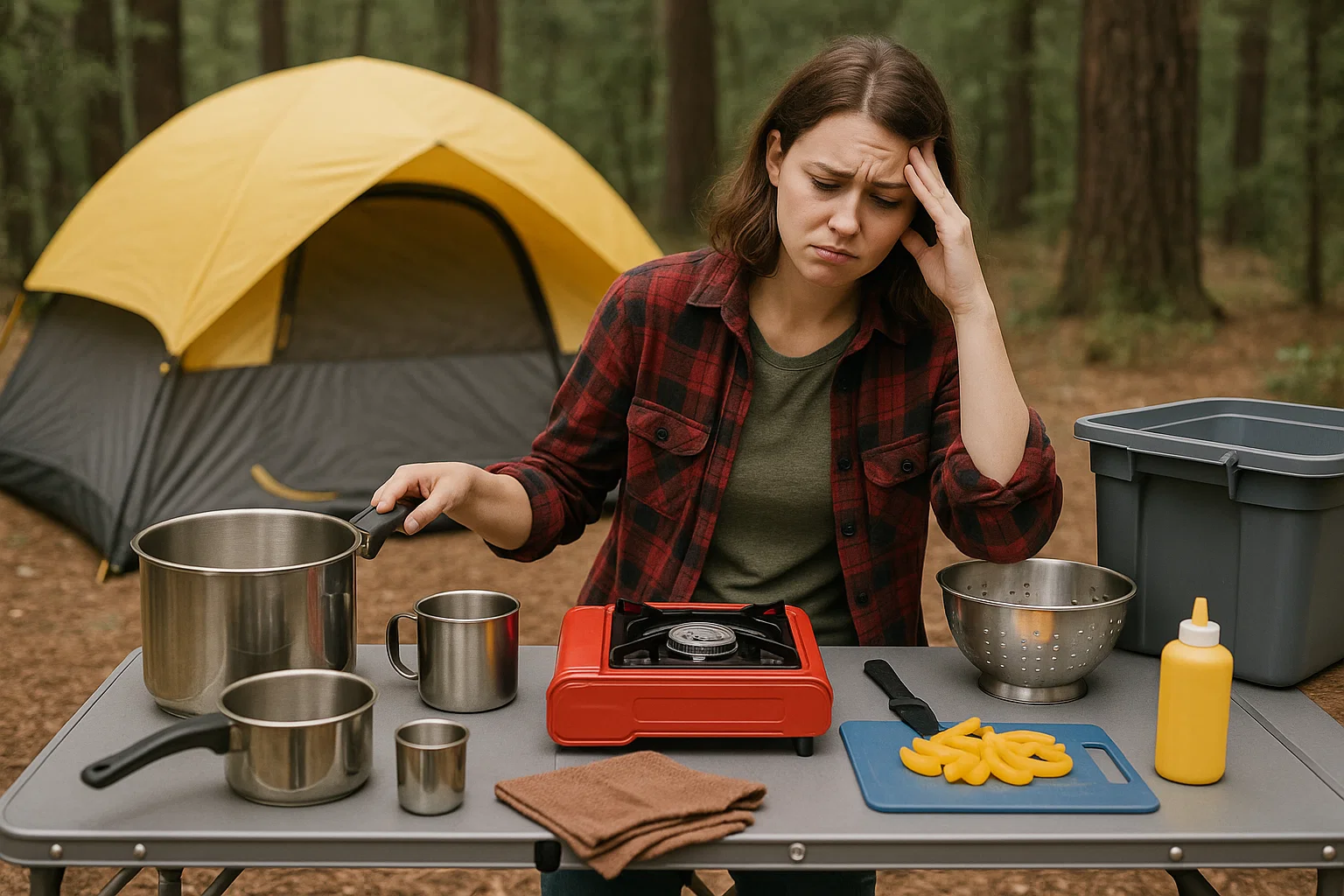You dreamed of savoring a hot meal under the stars — but now you’re staring at a mess of random camping gear, no clear plan, and a growing sense of stress.
Setting up a camp kitchen can feel overwhelming, especially if you’re new to outdoor cooking or trying to pack light.
Where does everything go? How do you stay organized without hauling your entire house into the wild?
You’re not alone. Most campers struggle with this at first.
The good news? You don’t need a huge RV or a professional setup to cook amazing meals outdoors.
With a few smart strategies, you can build a compact, easy-to-use camp kitchen that takes the stress out of cooking — and makes your trips way more enjoyable.
Here’s how to do it.
1. Start with the Right Foundation: A Portable Table and Cooking Surface
Problem:
Trying to cook on the ground or unstable rocks is frustrating (and dangerous).
Solution:
Invest in a simple folding camping table or a portable camp kitchen station. Look for ones that have:
- A flat prep surface
- An area to hold a camp stove
- Small shelves or hanging hooks for utensils
Good Options:
- GCI Outdoor Slim-Fold Cook Station
- Trekology Portable Camping Table
Tip:
If you’re ultra-lightweight backpacking, a basic aluminum roll-up table works just fine — it’s way better than cooking directly on dirt.
2. Simplify Cooking with a 2-Burner Camp Stove
Problem:
Balancing pans over a campfire is romantic — until your food burns or topples into the flames.
Solution:
A compact 2-burner camp stove offers reliable heat and way more control.
Best Choices:
- Coleman Classic Propane Stove (affordable and reliable)
- Camp Chef Everest 2X (more powerful and still portable)
Pro Tip:
Bring an extra small propane canister — you don’t want to run out mid-meal!
3. Stick to a Minimalist Cookware Kit
Problem:
Packing too many pots, pans, and gadgets clutters your camp kitchen and stresses you out.
Solution:
Keep it simple. You only really need:
- One medium pot
- One medium skillet
- One kettle or small pot for boiling water
- A spatula, serving spoon, and a good knife
Camping Cookware Sets:
Brands like GSI Outdoors or MSR offer lightweight nesting sets that save massive space.
4. Organize Like a Pro with Storage Bins
Problem:
Scattered utensils, missing spices, and endless rummaging through bags.
Solution:
Use 1-2 clear plastic bins to organize your entire kitchen.
Setup Tip:
- Bin 1: Stove, fuel, pots, utensils, cutting board, small dish soap, scrub sponge
- Bin 2: Food, seasonings, snacks, dry goods, cooler items
Label the bins or pick different colors to make them easy to grab.
5. Don’t Skip a Simple Water System
Problem:
Washing dishes becomes a nightmare if you don’t plan your water source ahead.
Solution:
Bring a collapsible water container (5–7 gallons) with a spout, plus two small tubs for a makeshift sink:
- One tub for washing
- One tub for rinsing
Bonus:
Add biodegradable soap and a packable dish rack if you want to feel like a real pro.
6. Choose Compact, Multi-Use Items
Problem:
Limited space means every item must earn its keep.
Solution:
Prioritize gear that serves double (or triple) duty:
- A pot lid that doubles as a frying pan
- A spork instead of separate fork and spoon
- A towel that dries dishes and acts as a potholder
Good Brands:
Sea to Summit, MSR, and GSI Outdoors specialize in smart, multi-use camping kitchen gear.
7. Pre-Prep Meals at Home (Save Massive Stress Later)
Problem:
Trying to dice onions, mince garlic, and measure spices while fighting wind and bugs is not fun.
Solution:
Do as much meal prep as possible before you leave home:
- Pre-chop veggies and store in zip-top bags or containers
- Pre-mix spice blends for each recipe
- Pre-make marinades or dressings in small squeeze bottles
Example:
Instead of carrying a full spice rack, make one “camp seasoning” blend that works on everything.
8. Think About Waste Management
Problem:
Trash and dirty dishes pile up fast without a plan.
Solution:
Set up a simple trash system:
- Hang a heavy-duty trash bag from your kitchen station
- Keep a separate bag for recyclables if needed
- Always pack out your garbage completely
Eco Tip:
Bring compostable trash bags if you\u2019re camping somewhere with a composting program.
9. Lighting Matters More Than You Think
Problem:
Cooking in the dark leads to burned meals and dangerous knife slips.
Solution:
Bring reliable lighting:
- A headlamp for hands-free cooking
- A compact LED lantern to hang above your cooking station
- Solar-powered fairy lights if you want cozy vibes
Pro Move:
Clip your lantern to your table frame for a mini “outdoor kitchen light.”
10. Bonus: Emergency Backup Cooking Option
Problem:
If your stove breaks, your lighter gets wet, or extreme weather hits, you still need to eat.
Solution:
Always pack a tiny backup:
- A pocket-sized backpacking stove (like the MSR PocketRocket)
- An ultra-light alcohol stove
- A no-cook meal like protein bars or canned soup
Even a tiny, reliable backup can save your trip.
Final Tips: Stress-Free Cooking is About Simplicity, Not Perfection
Remember:
The goal isn’t to replicate your home kitchen.
It’s to create a comfortable, functional cooking space that lets you enjoy the outdoors without unnecessary stress.
✅ Keep your setup minimal.
✅ Prep what you can at home.
✅ Stay flexible if weather or plans change.
By streamlining your camp kitchen and thinking a few steps ahead, you’ll not only eat better \u2014 you’ll relax more, enjoy your trip, and maybe even look forward to cooking under the stars.

